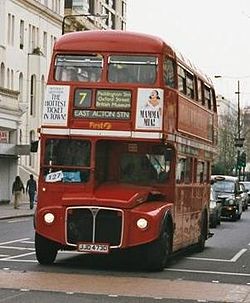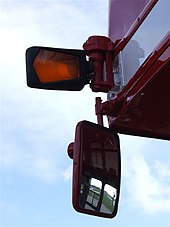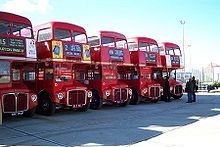Routemaster
| AEC / Park Royal Vehicles | |
|---|---|

AEC Routemaster RML 2473 in April 2002 |
|
| Routemaster | |
| Manufacturer | AEC / Park Royal Vehicles |
| design type | double-decker bus |
| Production period | 1959-1968 |
| axes | 2 |
| engine | RM / RMC: AEC 9.6L, Leyland 9.8L; RML / RMA / RCL / FRM: AEC 11.3 L; later: IVECO , DAF, Cummins , Scania |
| power | 86/113/131/134 kW |
| length | RM / RMC: 8.4 m, RML / RCL: 9.11 m, FRM: 10.97 m |
| width | 2.44 m |
| height | RM / RMA / RMC: 4.38 m, RML / RCL / FRM: 4.4 m |
| Seats | (bottom / top) RM: 28/36 = 64; RML: 32/40 = 72; RMC: 25/32 = 57; RCL: 29/36 = 65; RMA: 24/32 = 56; FRM: 31/41 = 72 |
| Perm. total weight | RM / RMC 11.7 t; RMA: 11.8 t; RML: 12.5 t; RCL: 12.45 t; FRM: 13.55 t kg |
| Previous model | AEC Regent III (RT) |
The AEC Routemaster is a biplane - bus , which from 1954 to 1968 by the Associated Equipment Company (AEC) specifically as a city and regional bus (bus Country Coach) for London Transport was created.
It has an innovative design and uses lightweight aluminum along with techniques developed in aircraft production during World War II. In addition to a new, weight-saving design, an independent suspension on the front axle, power steering , a fully automatic transmission and a brake booster were also introduced for the first time. The drivers, who knew the previous models, were surprised and found the bus to be unexpectedly light and nimble, especially as shown on the film during tests in the Chiswick Works compact tub. The footage from RM200, which was skid-tested in Chiswick, was included in the 1971 film On the Buses.
The Routemaster era

The Routemaster was constructed in the mid-1950s as the successor to the AEC Regent (RT, the London Transport standard double-decker of the 1940s and 50s RT). The first run of a Routemaster in London was on February 8, 1956.
The self-supporting aluminum body was mounted on a front axle and a rear axle bolster. The diesel engine was attached to the front axle bolster, and the four- speed semi-automatic transmission was under the floor in the middle of the vehicle. The drive took place on the rear axle with double tires. The first vehicles of the Routemaster design were 8.4 meters long (called RM = Routemaster), had 64 seats and went into operation between 1959 and 1962. To convert the London trolleybus operation to diesel buses, models with a length of half a window (called RML = "Routemaster long") with 72 seats were put into operation in 1962. From 1965 to 1968 only these 9.11 meter long RML and RCL were purchased. The two length variants can be easily distinguished in the side view by the additional, smaller window in the middle of the RML / RCL.
After extensive clarifications with the union, "one-man cars" were used on more and more London bus routes in the 1970s, saving the previously existing conductor (initially only during off- peak hours ). One wanted to counteract the shortage of staff and also hoped for cost savings. However, since the stay at the bus stop was greatly extended because the drivers now had to sell or check tickets, the new system was initially only used on less heavily used lines; in the city center one stayed with the car with the conductors. The advantage of the Routemaster, which was constructed in the old classic design (diesel engine at the front, open rear entry), was that in central London with its stop-and-go traffic, passengers could easily get on and off between the stops (“Hop on / Hop off ").
Some vehicles were initially painted green (RMC and RCL with more comfortable equipment for GreenLine Coaches = express buses to the suburbs and for London Country Bus Service LCBS = buses in the suburbs). From August 1969 to January 1976 a number of Routemasters (RM and RML) were provided with full advertising, with the entire outer body surface being used for brightly colored advertising for various companies or brands. For the 25th and 50th anniversary of the Queen's coronation, a number of Routemasters were also painted in silver or gold. After the London bus company was privatized in the 1980s, the vehicles of some new bus companies were also given other colors than red (e.g. Kentish Bus and Coach Co Ltd ). The most popular color scheme for the Routemaster is probably the red typical of London, which has been mandatory for city buses in central London for several years (at least 80% of the body surface).
The Routemaster buses were originally intended to be used for 17 years, but many of the buses have become much older. Due to the weight-saving aluminum construction, the structure is very durable. In the more than fifty years that the series has existed, a number of changes have been made to the vehicles. The Routemasters were given new diesel engines several times: while in 1962 and 1963 a number of new buses were fitted with Leyland engines, at the end of the 1980s tests were carried out with various diesel engines from other manufacturers ( Cummins , Ashok , DAF and Iveco ) in Routemaster buses. Subsequently, in 1990 and 1994, 500 of the RML fleet, which still consisted of 502 vehicles, received new Iveco engines. Of the shorter RMs, about a hundred vehicles received a new engine. In recent years, the buses have again received new, lower-emission diesel engines such. B. from Scania or Cummins, the interior was also refreshed (including new interior lighting), the old cranked windows replaced by hinged windows, the front indicators (typical for London buses of the 1960s) on the level of the lower deck roof and the rear lights by other types replaced.
The Routemaster series was until the introduction of the New Bus for London (next to the Leyland Titan ) as the last bus type specially designed for London.
Withdrawal from the action and the end of the Routemaster era

Since the Routemaster buses are not handicapped accessible , an EU directive in the 2000s forced them to use vehicles with low-floor technology on the last lines and to retire the old buses. Many cars, especially the shorter RMs, were sold earlier. After the end of the regular service period in the 1980s, many vehicles were replaced by newer one-man double-deckers; A number of wagons were even scrapped, others went to other transport companies in England and Scotland, some of which were later bought back. Today the old wagons are popular attractions not only for enthusiasts.
Between August 29, 2003 and December 9, 2005, operations on the last twenty London lines, on which Routemaster were still in use on weekdays, were gradually switched to other bus types:
| line | route | Traffic Company | Last drive |
|---|---|---|---|
| 6th | Aldwych - Trafalgar Square - Piccadilly Circus - Oxford Circus - Marble Arch - Queen's Park - Kensal Rise | Metroline | March 26, 2004 |
| 7th | Russell Square - British Museum - Oxford Street - Paddington Station - Ladbroke Grove - East Acton Station | First | July 2, 2004 |
| 8th | Bow Church - Liverpool Street - Bank - St. Paul's - Holborn - Oxford Circus - Victoria Station | Stagecoach | June 3, 2004 |
| 9 | Aldwych - Charing Cross - Piccadilly - Hyde Park Corner - Kensington - Hammersmith | London United | September 3, 2004 |
| 11 | Liverpool Street Station - Fleet Street - Charing Cross - Victoria - Chelsea - Fulham Broadway | London General | October 31, 2003 |
| 12 | Notting Hill Gate - Oxford Circus - Whitehall - Westminster - Elephant & Castle - Camberwell - Peckham - Dulwich Plow | London Central | November 5, 2004 |
| 13 | Aldwych - Beach - Piccadilly Circus - Regent Street - Oxford Street - Finchley Road - Golders Green | London United | October 21, 2005 |
| 14th | Tottenham Court Road - Piccadilly - Hyde Park Corner - South Kensington - Fulham - Putney Heath | London Central | July 22, 2005 |
| 15th | East Ham - Poplar - Aldgate - Bank - Trafalgar Square - Oxford Circus - Paddington Station | Stagecoach | August 29, 2003 |
| 19th | Finsbury Park Station - Highbury - Islington - Piccadilly - Knightsbridge - Sloane Square - Chelsea - Battersea Bridge | Arriva London | April 1, 2005 |
| 22nd | Piccadilly Circus - Hyde Park Corner - Sloane Square - Chelsea - Parsons Green - Putney Common | London Central | July 22, 2005 |
| 23 | Liverpool Street - Trafalgar Square - Oxford Street - Paddington Station - Westbourne Grove | First | November 14, 2003 |
| 36 | Queen's Park - Paddington - Marble Arch - Victoria - Camberwell - Peckham - New Cross Gate | Arriva London | April 1, 2005 |
| 38 | Clapton Pond - Hackney - Dalston - Islington - Bloomsbury - Piccadilly - Victoria Station | Arriva London | October 28, 2005 |
| 73 | Tottenham - Islington - King's Cross - Euston - Oxford Street - Hyde Park Corner - Victoria Station | Arriva London | September 3, 2004 |
| 94 | Trafalgar Square - Oxford Circus - Queensway - Notting Hill - Shepherds Bush - Acton Green | London United | January 23, 2004 |
| 98 | Holborn - Trafalgar Square - Piccadilly Circus - Oxford Circus - Marble Arch - Queen's Park - Willesden | Metroline | March 26, 2004 |
| 137 | Oxford Circus - Knightsbridge - Sloane Square - Battersea Park - Clapham Common - Streatham Hill | Arriva London | July 9, 2004 |
| 159 | Marble Arch - Trafalgar Square - Whitehall - Westminster - Kennington - Brixton - Streatham Station | Arriva London | December 9, 2005 |
| 390 | Marble Arch - Oxford Street - Euston - King's Cross - Archway | Metroline | September 3, 2004 |
The last regular service of the Routemaster took place on December 9, 2005 and is considered to be the end of the Routemaster era in London. Since then, buses of this type ("Heritage Routemaster") have been running regularly on sections of bus routes 9 and 15 in central London, and since July 26, 2014 only bus routes of this type have been running regularly. The vehicles shaped the cityscape for almost 50 years and are still considered a symbol of London today ("Take a trip on a London landmark" - inscription on some of the Heritage Routemasters). The vehicles were partly due to modern low-floor -Doppeldecker, partly through in Germany produced articulated buses of the type Mercedes-Benz O 530 Citaro of EvoBus replaced that for in the UK ruling left-hand traffic as right-hand drive are made.
Routemaster outside London
As a result of the deregulation of public bus transport, used Routemasters began to be used in other British cities from 1986. The Clydeside Scottish company acquired 114 vehicles for use in Glasgow . Other Routemasters drove among others in Manchester , Perth and Southampton . In Brighton there is a Routemaster on line in the summer season in the 2010s (Brighton & Hove).
Routemaster Heritage Routes
Due to numerous protests against the closure of the Routemaster buses on the London bus routes, Transport for London decided to use some Routemasters on two routes. These lines are called "Routemaster Heritage Routes" and are shortened versions of the existing lines (see table above), which are now served by low-floor buses:
- Heritage Route 9 : Kensington High Street - / Royal Albert Hall - Hyde Park Corner - Piccadilly Circus - Trafalgar Square - Strand - Aldwych and back
- daily from 9:30 a.m. to 6:30 p.m. every 15 minutes. Routemasters from the First transport company were used .
- This line was discontinued on July 25, 2014.
- Heritage Route 15 : Trafalgar Square - Strand - Aldwych - Fleet Street - Cannon Street Station - Monument - Tower Hill and back
- Since March 2, 2019 only on weekends and bank holidays (Bank Holidays). Routemasters from Stagecoach London are used .
19 buses were required for the courses on these two lines, more are kept in reserve. The buses are equipped in such a way that they meet today's emission standards.

Routemaster as a role model
New Bus for London
The New Bus for London will also be equipped with a rear platform by Wrightbus as the "successor" to the Routemaster . This hybrid bus , which is used especially at the request of the then London Mayor Boris Johnson , has been in passenger service since February 20, 2012. The NB4L is therefore also called "Borismaster".

Yutong City Master
In the Macedonian capital Skopje , a total of over 200 new red double-deckers have been in operation since 2011/12, which were manufactured by the Chinese company Yutong based on the London model. Some examples have an open upper deck. Despite the historicizing design, these are technically modern vehicles. At first they seem strange in the Balkan cityscape, but it is a reintroduction. As early as 1960 there were a number of second-hand London RT double-deckers purchased in Skopje that disappeared from the cityscape around the time of the great earthquake of July 26, 1963.
gallery
Former Open Top Routemaster, converted into a sightseeing bus in London , on a city tour in Toronto on July 2, 2005
Original furnishings of the lower deck with bell cord , illuminated interior advertising and a view of the driver's cab (RM 1414)
Individual evidence
- ↑ http://www.londonbooks.co.uk/shop/page.php?xPage=articles.html&articleID=1
- ↑ http://www.routemaster.org.uk/pages/history
- ↑ http://www.screen.busesonscreen.net/screen1/index.php?p=screenfm.fmo.onthebusesfilm
- ↑ No more Heritage Routemasters on weekdays Londonist, accessed May 4, 2019
- ↑ AECs in service










